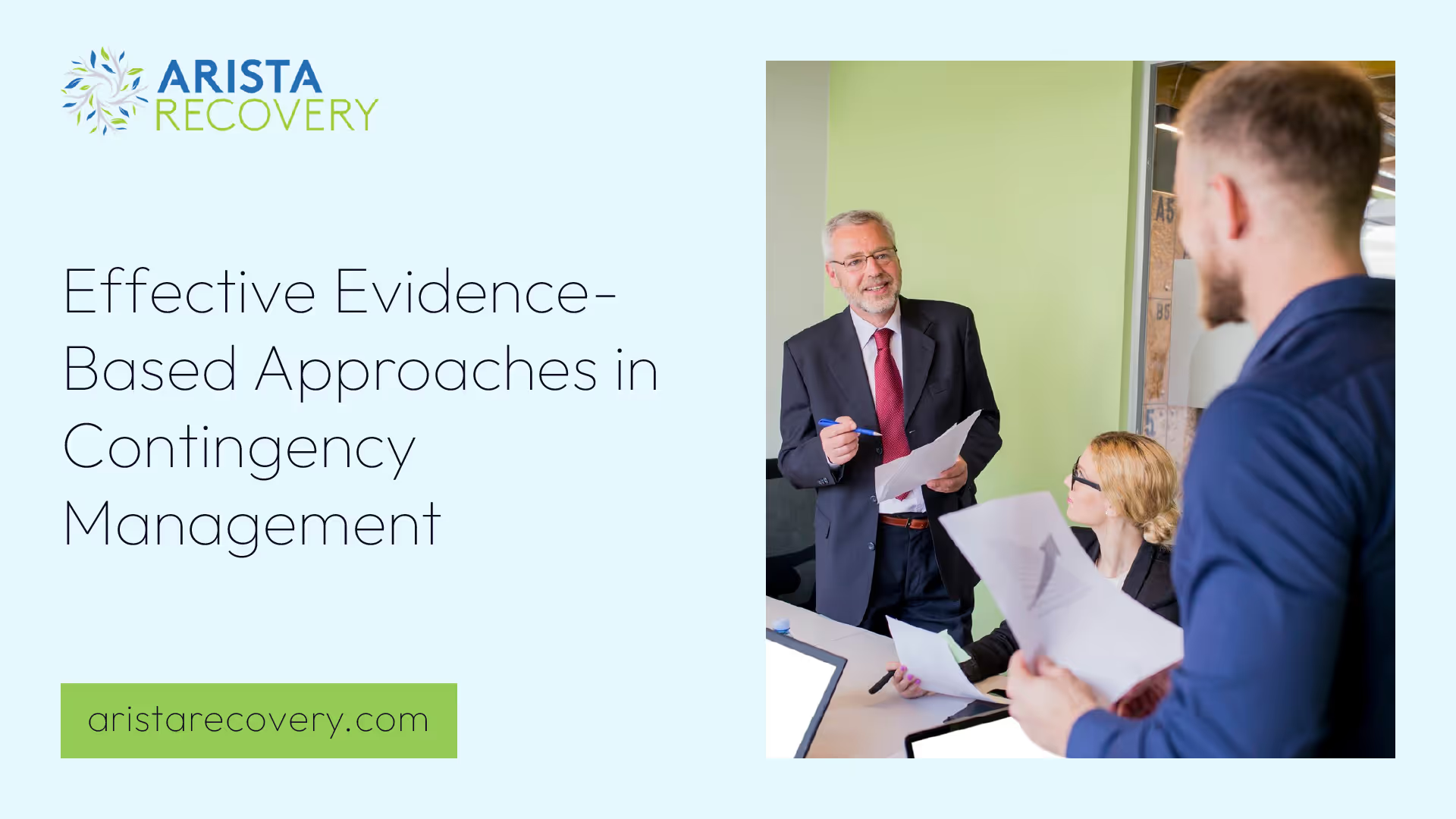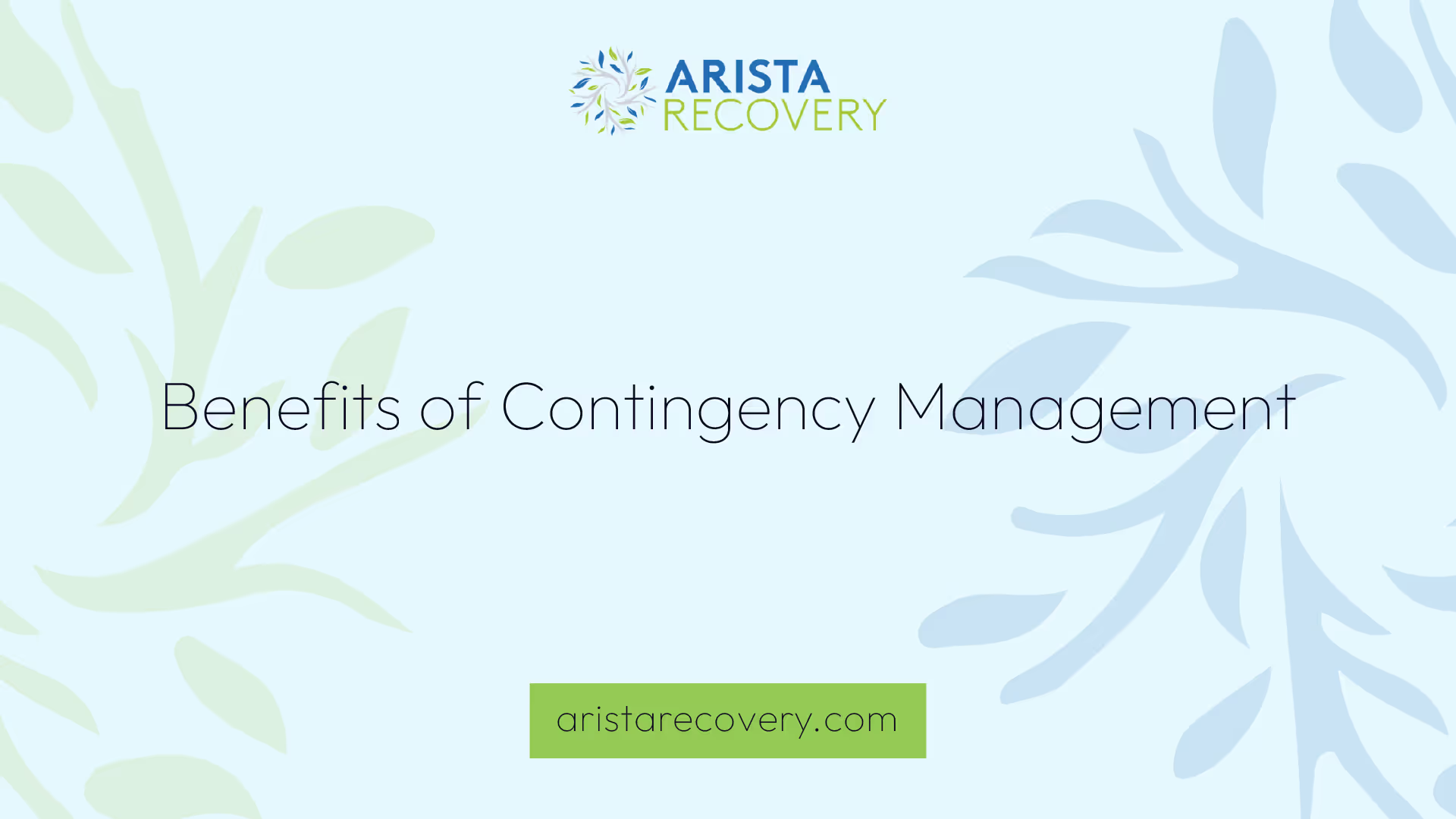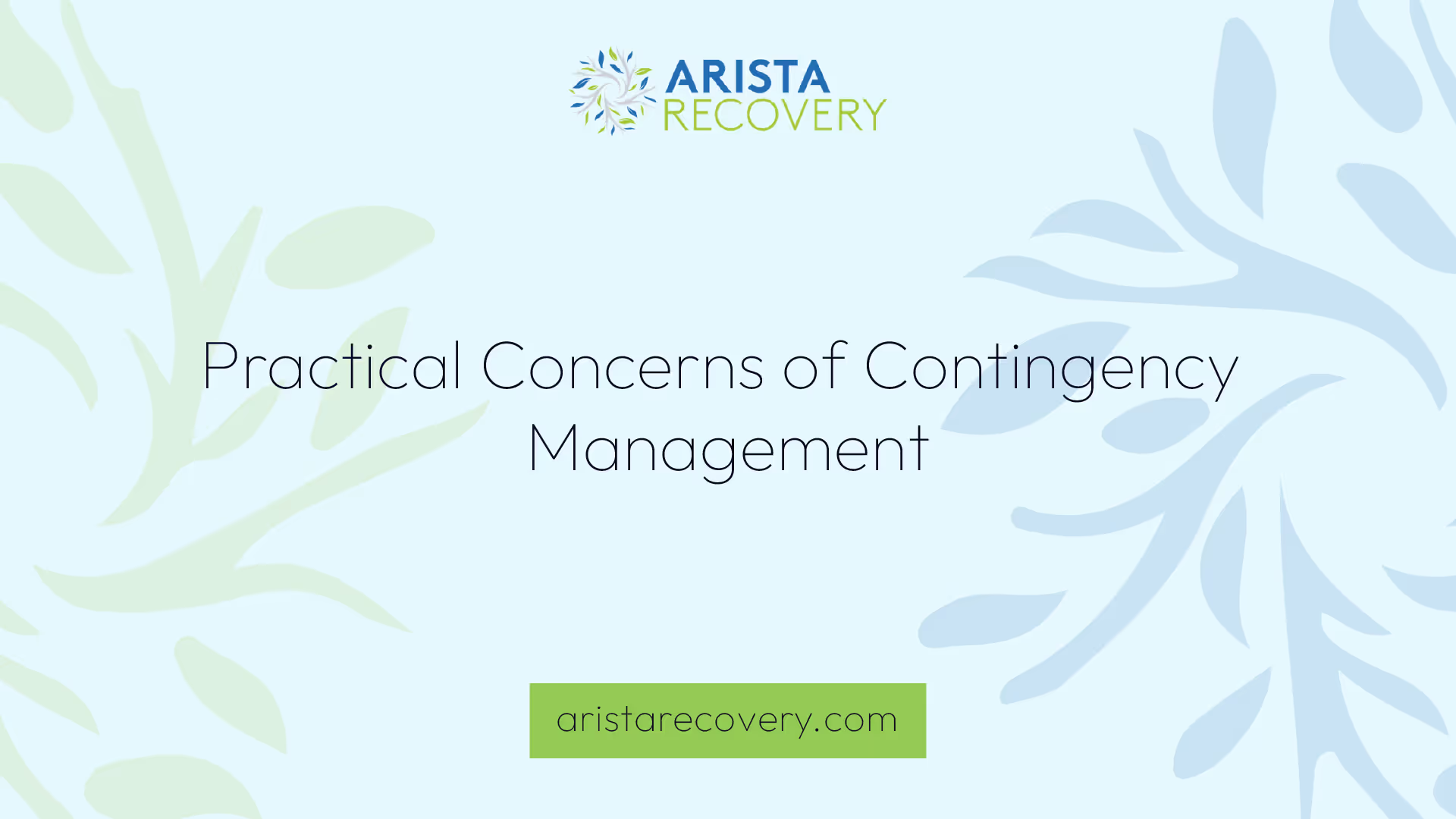Effective Evidence-Based Approaches in Contingency Management


Understanding Contingency Management
Contingency management (CM) is an evidence-based approach in behavioral modification that has proven to be highly effective in the treatment of substance use disorders (SUDs) [1]. It involves providing reinforcement or incentives in exchange for objective evidence of desired behaviors, such as abstinence from drugs or alcohol. By utilizing positive reinforcement, CM aims to increase the likelihood of behavior change and promote long-term recovery.
Definition and Principles
The core principle of contingency management is to provide immediate and tangible rewards for individuals who engage in desired behaviors, such as abstaining from substance use or meeting treatment goals. Rewards can take various forms, including vouchers, retail items, or privileges, and are typically provided in close temporal proximity to the observed behavior. By associating positive consequences with the desired behavior, individuals are motivated to continue engaging in those behaviors.
The effectiveness of contingency management lies in its ability to harness the power of positive reinforcement. Studies have consistently shown that rewards are more effective than punishments in modifying behavior, and even small or non-monetary rewards can significantly impact behavior change [2]. The frequency of reinforcement also plays a crucial role in efficacy, with more frequent reinforcement leading to better outcomes.
Efficacy and Implementation
Contingency management has demonstrated effectiveness across a range of populations and substances. It has been found to improve engagement in treatment, enhance retention, facilitate skill acquisition, and increase abstinence rates among individuals with substance use disorders. It has shown particular success in treating opioid, stimulant, and cannabis use disorders, as well as populations that are historically difficult to treat, such as individuals with antisocial personality disorder or those experiencing homelessness and co-occurring psychiatric conditions [2].
Implementation of contingency management in substance use treatment may involve various strategies. One example is the voucher program, which reinforces abstinence from drug use by providing vouchers for negative urine specimens. These vouchers can be used to purchase retail items in the community, and their value increases with consecutive negative specimens, incentivizing continuous abstinence.
Incorporating contingency management into treatment programs requires careful planning and coordination. Treatment providers need to establish clear guidelines and protocols for reinforcement, ensure accurate monitoring of behaviors, and regularly evaluate the effectiveness of the intervention. Implementing contingency management alongside other behavioral therapies, such as cognitive-behavioral therapy (CBT) or family therapy, can further enhance treatment outcomes.
By understanding the definition and principles of contingency management and recognizing its efficacy and implementation strategies, psychiatrists and treatment providers can utilize this evidence-based approach to enhance the effectiveness of substance use treatment. Incorporating contingency management techniques into therapy can improve outcomes, increase treatment engagement, and promote long-term recovery. To learn more about the practical concerns and innovations in contingency management, continue reading our article on contingency management techniques for psychiatrists.

Benefits of Contingency Management
Contingency management (CM) is an evidence-based approach that has shown promising results in the field of addiction treatment. It utilizes positive reinforcement to promote behavioral changes and support individuals in achieving abstinence from substance use. In this section, we will explore two key benefits of contingency management: long-term abstinence predictors and its impact on behavioral changes.
Long-Term Abstinence Predictors
Research has indicated that individuals who receive contingency management continue to benefit even after tangible reinforcers are no longer available. The longest duration of abstinence achieved during treatment is considered a predictor of long-term abstinence. This suggests that the positive effects of CM can extend beyond the treatment period, leading to sustained abstinence from substance use.
Impact on Behavioral Changes
Contingency management interventions involve reinforcing positive behavioral changes by providing monetary-based reinforcers for drug-negative urine specimens. These interventions have been widely tested and evaluated in the context of substance misuse treatment, with evidence supporting their efficacy. CM has been shown to increase abstinence rates and treatment retention, contributing to positive outcomes in substance use treatment.
Data indicate that CM interventions have no adverse effects on internal motivation. In fact, effective CM interventions are designed to reduce the probability of drug lapses by arranging reinforcers in a way that promotes sustained abstinence. By reinforcing drug-negative behaviors, CM helps individuals develop healthier coping mechanisms and encourages the adoption of a drug-free lifestyle.
The effectiveness of contingency management in promoting abstinence and facilitating behavioral changes is supported by numerous studies. It has been recognized as a highly effective treatment for substance use and related disorders. The immediacy, frequency, and magnitude of reinforcement are key factors associated with enhanced substance abstinence in CM interventions. Providing more immediate, frequent, and higher magnitude reinforcers has been shown to enhance the efficacy of CM.
By harnessing the power of positive reinforcement, contingency management offers significant benefits to individuals seeking treatment for substance use disorders. It provides a structured framework to support long-term abstinence and encourages positive behavioral changes that contribute to overall recovery. Psychiatrists and treatment providers can utilize contingency management techniques to enhance treatment outcomes and improve the well-being of their patients. To learn more about the practical implementation of contingency management in therapy, visit our article on using contingency management in therapy.

Practical Concerns of Contingency Management
While contingency management (CM) has shown promise as an effective approach in behavior change and substance use treatment, there are practical concerns that need to be considered. These concerns include administration challenges and cost-effectiveness.
Administration Challenges
One of the main administration challenges of contingency management is the need for frequent urine sample collection and testing. This process can be time-consuming and may require additional resources in terms of staffing and laboratory facilities. However, urine testing plays a crucial role in monitoring abstinence and reinforcing positive behaviors [3].
To address these challenges, clinics and treatment programs implementing contingency management may need to establish efficient systems for sample collection, processing, and result reporting. This can involve collaboration with qualified laboratories, trained staff, and streamlined procedures to ensure the smooth administration of the program.
Cost-Effectiveness
Another practical concern related to contingency management is its cost-effectiveness. Studies funded by the National Institute on Drug Abuse (NIDA) have shown that contingency management is effective for treating substance use disorders, with incentives averaging $400-$500 per patient or more over the course of treatment. However, lower incentives have been found to be inconsistent in producing desired outcomes.
The costs associated with monetary-based reinforcers can impact the efficacy of contingency management. Additionally, the annual limits set by CMS (Centers for Medicare & Medicaid Services) and states for incentive payments, typically ranging from $75-$100, may be insufficient for effective implementation of contingency management.
To ensure the cost-effectiveness of contingency management, it is essential to consider the value of incentives provided and their impact on behavioral change outcomes. Studies and evaluations can help determine the optimal incentive levels and develop strategies to maximize the benefits of contingency management within available resources.
In summary, while contingency management has demonstrated efficacy in promoting behavior change and treating substance use disorders, practical concerns such as administration challenges and cost-effectiveness need to be addressed for successful implementation. By developing efficient systems for sample collection and testing and considering the value of incentives provided, the benefits of contingency management can be maximized for individuals seeking treatment and support.
Contingency Management in Substance Use Treatment
Contingency management (CM) has emerged as an effective approach in the treatment of substance use disorders (SUDs). It utilizes a behavior-modification method that provides reinforcement in exchange for objective evidence of a desired behavior. CM has shown efficacy across different substances, making it a valuable tool in addiction treatment.
Effectiveness Across Different Substances
Studies conducted in the USA have demonstrated the effectiveness of contingency management for treating various substance use disorders. It has been found to be efficacious in reducing the use of opioids, alcohol, marijuana, benzodiazepines, and even cigarettes. Individuals with stimulant misuse who received contingency management treatment showed significantly enhanced retention in treatment and higher rates of sustained abstinence compared to standard care groups [4].
The versatility of contingency management in addressing different substances makes it a valuable approach for individuals with diverse addiction problems. By providing incentives for desired behaviors, such as abstinence or adherence to treatment, contingency management offers a tangible reward system that motivates individuals to make positive changes in their substance use patterns.
Meta-Analytic Reviews
Meta-analytic reviews have consistently demonstrated the effectiveness of contingency management in the treatment of substance use disorders. These reviews have indicated that CM interventions have moderate-sized effects for reducing substance use at posttreatment compared to non-contingent reinforcement control groups or treatment-as-usual. Furthermore, the effects of CM have been shown to remain superior to control groups at long-term follow-ups [5].
The evidence from meta-analytic reviews supports the use of contingency management as one of the most effective behavioral interventions for initiating and maintaining abstinence from alcohol and drugs. Its robust effect sizes make it a valuable tool for clinicians and therapists working with individuals with substance use disorders.
In summary, contingency management has proven to be effective across different substances, offering a promising approach in the treatment of substance use disorders. Its effectiveness is supported by meta-analytic reviews, which demonstrate its superiority over control groups and its long-term impact. By leveraging the principles of reinforcement, contingency management provides individuals with tangible incentives to motivate and sustain positive behavior change in their recovery journey. For more information on the techniques and applications of contingency management, explore our article on contingency management techniques for psychiatrists.
Overcoming Barriers to Contingency Management
Despite its proven efficacy, contingency management, an evidence-based approach in contingency management, is the treatment with which many mental health providers are least familiar [4]. This lack of familiarity has led to underutilization of this powerful intervention for people with addiction problems. However, with the right knowledge and strategies, it is possible to overcome the barriers associated with contingency management.
Lack of Familiarity
One of the main barriers to the implementation of contingency management is the lack of familiarity among mental health providers. Surveys indicate that few clinicians are aware of this intervention, which can hinder its adoption and utilization. It is crucial to raise awareness and provide education and training opportunities for mental health professionals to familiarize themselves with the effectiveness and techniques of contingency management. By increasing knowledge and understanding, clinicians can confidently incorporate this evidence-based approach into their practice and improve patient outcomes.
To address the lack of familiarity, national campaigns have been launched to raise awareness and interest in using incentives as an adjunct therapy to treat substance use disorders. For example, the National Institute of Drug Abuse (NIDA) and the Addiction Technology Transfer Network introduced the Promoting Awareness of Motivational Incentives (PAMI) toolkit, which provides clinicians with resources and information on implementing contingency management. Additionally, the Motivational Incentives Suite, developed by NIDA and SAMHSA-ATTC, offers low-cost online courses and implementation software to support the effective use of incentives in treatment [7]. These resources can help mental health providers overcome the lack of familiarity and gain confidence in using contingency management.
Implementation Challenges
Another barrier to the widespread implementation of contingency management is the presence of various challenges during the implementation process. These challenges can include logistical issues, limited resources, and concerns about costs. Implementing contingency management may require additional time, effort, and coordination to establish a system for monitoring and delivering incentives effectively.
To overcome these implementation challenges, it is essential to develop clear and practical guidelines for integrating contingency management into existing treatment programs. Providing training and support to the staff involved in the implementation can also help address any concerns and ensure a smooth transition. Additionally, exploring potential funding sources or reimbursement options can help offset the costs associated with the provision of incentives.
By addressing the implementation challenges and providing support to mental health providers, contingency management can become more accessible and widely used in the treatment of substance use disorders. The evidence supporting its efficacy, combined with proper training and resources, can empower clinicians to effectively implement this evidence-based approach and improve treatment outcomes for individuals with addiction problems.
By overcoming the lack of familiarity and addressing implementation challenges, contingency management can be integrated successfully into psychiatric practice, providing individuals with addiction problems in Kansas and beyond with a powerful tool for positive change.
Innovations in Contingency Management
As the field of addiction treatment continues to evolve, so does the approach to contingency management. Innovations in technology and the expanding applications of contingency management (CM) techniques are revolutionizing the way psychiatrists and clinicians approach substance use disorder (SUD) treatment. In this section, we will explore two key areas of innovation: technological advancements and diverse applications of contingency management.
Technological Advancements
Technological advancements have opened up new possibilities in the realm of contingency management. For instance, mobile delivery of reinforcers in exchange for objective evidence of desired behavior has become increasingly common. This approach allows for individualized goal setting and the delivery of CM-based SUD treatment in hard-to-reach places, potentially impacting communities that are most affected by these disorders.
These technological advancements, coupled with new biomarkers, have empowered clinicians to personalize CM interventions. By leveraging mobile devices and objective measures of behavior, such as negative urine specimens, clinicians can provide immediate reinforcement and increase the likelihood of continuous abstinence from substances like cocaine [2]. The immediacy, frequency, and magnitude of reinforcement play a significant role in enhancing CM efficacy, and technological advancements allow for more precise and tailored reinforcement delivery.
Diverse Applications
Contingency management techniques are not limited to specific substances or treatment settings. They can be applied to a wide range of substances, including opioids, cocaine, and alcohol. When used in combination with medication for opioid use disorder (MOUD), CM has shown to reduce illicit opioid use, increase medication adherence, and improve therapy attendance [2]. Additionally, CM can be combined with other behavioral therapies, such as social skills training, counseling, and cognitive-behavioral therapy (CBT), to enhance treatment outcomes [2].
Furthermore, contingency management techniques have expanded beyond traditional treatment settings. With the help of technological advancements, CM interventions can now be effectively delivered in diverse settings, including remote or hard-to-reach locations. This is especially significant for communities that are disproportionately affected by substance use disorders, as it increases accessibility to evidence-based treatment [1].
The ongoing innovations in contingency management are transforming addiction treatment by providing more personalized, immediate, and accessible interventions. By leveraging technology and expanding the applications of CM techniques, psychiatrists and clinicians can enhance treatment outcomes and improve the lives of individuals struggling with substance use disorders. It is essential for practitioners to stay informed about these innovations and consider integrating contingency management into their treatment approaches. For more information on specific techniques and strategies, refer to our article on contingency management techniques for psychiatrists.
References
[2]:
[3]:
[4]:
[5]:
[6]:
[7]:
You’re not alone in this.
When mental health challenges and addiction intersect, it can feel isolating. At Arista, we offer compassionate, evidence-based, and trauma-informed care to help you heal, grow, and move forward.
You’re not alone in this.
When mental health challenges and addiction intersect, it can feel isolating. At Arista, we offer compassionate, evidence-based, and trauma-informed care to help you heal, grow, and move forward.
Support that moves with you.
You’ve taken a brave first step. At Arista Recovery, we’re here to help you continue with best-in-class care designed for long-term healing and support.
.webp)






